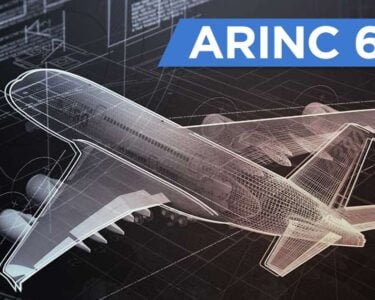ARINC 629 stands as a cornerstone in aviation’s data communication architecture, providing a robust standard for the seamless exchange of data among critical avionics systems. Developed by ARINC, it offers a reliable means of transmitting data, enhancing the safety and efficiency of flight operations. In the broader context of aircraft systems, standardized data bus protocols like ARINC 629 are essential for establishing seamless communication pathways, ensuring interoperability, and integrating diverse avionics equipment. They lay the groundwork for efficient data transmission, vital for the functioning of modern aircraft.
Benefits of Implementing ARINC 629
Implementing ARINC 629 in aircraft systems offers a multitude of advantages, ranging from improved data transfer rates to increased reliability and cost efficiency. Here are some key benefits:
Enhanced Data Transfer Rates
- ARINC 629 provides significantly higher bandwidth compared to older standards such as ARINC 429.
- This increased bandwidth enables the transmission of larger volumes of data at faster speeds, facilitating more efficient communication between avionics systems.
- With the growing complexity of modern aircraft systems and the increasing demand for real-time data exchange, this enhanced data transfer capability is crucial for supporting various avionics functions, including flight control, navigation, and surveillance systems.
Improved System Flexibility and Scalability
- One of the notable advantages of ARINC 629 is its modular architecture, which allows for easier integration of new systems and components into existing avionics configurations.
- This flexibility enables aircraft manufacturers and operators to adapt to evolving technological requirements and customer preferences more efficiently.
- Additionally, the scalability of ARINC 629 facilitates the incremental expansion of avionics capabilities without the need for extensive redesign or rewiring, thereby reducing both time and costs associated with system upgrades.
Increased Reliability and Safety
- ARINC 629 incorporates robust error detection and correction mechanisms, as well as fault tolerance features, which contribute to the overall reliability and safety of aircraft systems.
- By detecting and mitigating communication errors in real-time, ARINC 629 helps prevent data corruption and ensures the integrity of critical avionics information.
- Moreover, the redundancy built into ARINC 629 networks, including redundant communication paths and backup configurations, enhances system resilience and fault tolerance, reducing the risk of single points of failure and enhancing overall system reliability.
Cost Efficiency Over Time
- While the initial implementation of ARINC 629 may require a significant investment in new infrastructure and training, the long-term cost benefits outweigh the upfront expenses.
- By streamlining avionics communication and reducing the need for complex wiring and connectors, ARINC 629 helps lower maintenance costs over the lifecycle of the aircraft.
- Furthermore, the scalability and modularity of ARINC 629 enable operators to adapt to changing requirements and technological advancements more cost-effectively, minimizing the need for costly retrofitting or system replacements in the future.
Challenges of Implementing ARINC 629
Implementing ARINC 629 in aircraft systems presents several challenges that need to be carefully addressed to ensure successful integration and operation. These challenges encompass technical, financial, and regulatory aspects, which demand meticulous planning and execution. Understanding and mitigating these challenges are crucial for maximizing the potential benefits of ARINC 629. Below are some key challenges:
Complexity and Technical Challenges
- Steep Learning Curve: Engineers and technicians may encounter difficulties in mastering the intricacies of ARINC 629 due to its complex architecture and communication protocols. Adequate training and education programs are essential to equip personnel with the necessary skills.
- Integration Complexity: Integrating ARINC 629 into existing aircraft systems can be challenging, particularly in older aircraft with legacy architectures. Ensuring seamless interoperability between ARINC 629 and other avionics systems requires meticulous planning and thorough testing.
Initial Implementation Costs
- High Initial Investment: The initial cost of implementing ARINC 629 infrastructure, including hardware, software, and training, can be substantial. Aircraft operators and manufacturers need to allocate significant financial resources upfront, which may pose a barrier to adoption, especially for smaller organizations.
- Training Expenses: Training personnel to design, install, and maintain ARINC 629 systems adds to the implementation costs. Specialized training programs tailored to the specific requirements of ARINC 629 are necessary to ensure competent workforce readiness.
Compatibility and Interoperability Issues
- Integration with Legacy Systems: Retrofitting ARINC 629 into aircraft with legacy avionics systems presents compatibility challenges. Ensuring seamless integration without disrupting existing functionalities requires meticulous planning and possibly additional modifications to legacy systems.
- Interoperability with Other Standards: Achieving interoperability between ARINC 629 and other data bus standards, such as ARINC 429 or MIL-STD-1553, can be complex. Harmonizing communication protocols and addressing protocol conflicts are essential to facilitate smooth data exchange between different systems.
Certification and Regulatory Hurdles
- Stringent Aviation Standards: Compliance with rigorous aviation regulations and certification requirements adds complexity to the implementation of ARINC 629. Demonstrating compliance with safety, reliability, and performance standards mandated by aviation authorities is a time-consuming and resource-intensive process.
- Extended Certification Processes: Obtaining certification for ARINC 629-equipped aircraft and components involves rigorous testing and validation procedures. Delays in certification approvals can prolong the time-to-market and increase project costs, requiring careful coordination with regulatory authorities.
Conclusion
In conclusion, the implementation of ARINC 629 in aircraft systems offers significant benefits in terms of enhanced data transfer rates, improved system flexibility, and increased reliability. However, these advantages come with a set of challenges that must be carefully navigated. The complexity of ARINC 629, coupled with high initial implementation costs and compatibility issues with legacy systems, underscores the importance of thorough planning and investment. Addressing these challenges requires collaboration among stakeholders, including aircraft manufacturers, avionics suppliers, and regulatory authorities, to ensure seamless integration and compliance with aviation standards.
Looking ahead, the future of ARINC 629 holds promise for further technological advancements and industry adoption. Continued innovation and standardization efforts will contribute to overcoming existing challenges and unlocking new opportunities for enhancing aircraft communication and avionics systems. By addressing the challenges and capitalizing on the benefits of ARINC 629, the aviation industry can advance towards safer, more efficient, and technologically advanced aircraft systems.






